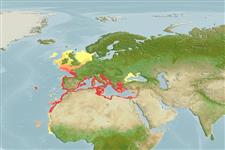Common names from other countries
>
Eupercaria/misc (Various families in series Eupercaria) >
Sparidae (Porgies)
Etymology: Pagellus: Diminutive of Latin, pager, derived from Greek, pagros = a fish, Dentex sp. (Ref. 45335).
More on author: Linnaeus.
Environment: milieu / climate zone / depth range / distribution range
Ecología
marino bentopelágico; rango de profundidad ? - 300 m (Ref. 4781), usually 20 - 100 m (Ref. 4781). Subtropical; 63°N - 10°N, 32°W - 42°E
Eastern Atlantic: Norway and the Mediterranean to Guinea-Bissau (Ref. 26999), including Cape Verde, Madeira and the Canary Islands. Rarely recorded in Scandinavia (Ref. 4781).
Length at first maturity / Tamaño / Peso / Age
Maturity: Lm 14.2, range 13 - 16 cm
Max length : 60.0 cm SL macho / no sexado; (Ref. 4781); common length : 25.0 cm SL macho / no sexado; (Ref. 4781); peso máximo publicado: 3.2 kg (Ref. 40637)
Espinas dorsales (total): 12; Radios blandos dorsales (total): 10-11; Espinas anales 3; Radios blandos anales: 8 - 9. Body red without stripes or bars. Snout at least twice as long as the eye diameter (Ref. 35388).
Found on inshore waters, on various bottom (rock, gravel, sand and mud) to 200 m (Mediterranean) or 300 m (Atlantic) and move to deeper waters during winter. Omnivorous, but feed mainly on benthic invertebrates and small fishes (Ref. 3688). Protogynic hermaphrodites, females become males first in their third year with sizes of about 17 cm. Important food fish.
Possibly two spawning periods in the southern Mediterranean (Ref. 4781). Length at which sex change possibly occurs is between 12.8 and 20.3 cm FL (Ref. 57849).
Bauchot, M.-L. and J.-C. Hureau, 1990. Sparidae. p. 790-812. In J.C. Quero, J.C. Hureau, C. Karrer, A. Post and L. Saldanha (eds.) Check-list of the fishes of the eastern tropical Atlantic (CLOFETA). JNICT, Lisbon; SEI, Paris; and UNESCO, Paris. Vol. 2. (Ref. 3688)
IUCN Red List Status (Ref. 130435)
Can't connect to MySQL database (fbapp). Errorcode: Too many connections
